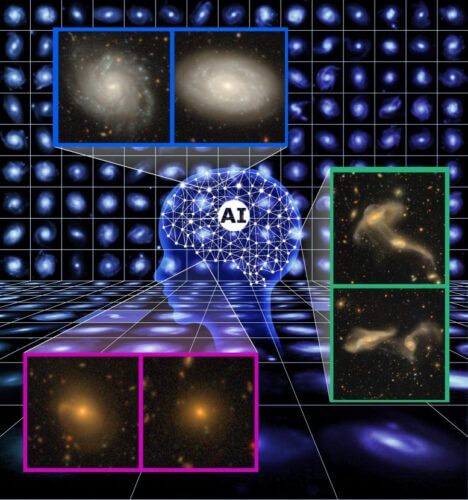Astronomers have applied artificial intelligence (AI) to ultra-wide-field images of the deep universe as taken by Japan's Subaru Telescope, achieving very high accuracy for detecting and classifying spiral galaxies in these images. This technique, combined with citizen scientists, is expected to yield more discoveries in the future

An illustration of the way the AI classifies galaxies of different types based on their morphologies. Credit: NAOJ / HSC-SSP
Astronomers have applied artificial intelligence (AI) to ultra-wide-field images of the deep universe as taken by Japan's Subaru Telescope, achieving very high accuracy for detecting and classifying spiral galaxies in these images. This technique, combined with citizen scientists, is expected to yield more discoveries in the future.
A research group composed of astronomers, mostly from the National Astronomical Observatory of Japan (NAOJ), used a deep learning technique, a type of AI, to classify galaxies in a large data set obtained by the Subaru Telescope. Thanks to the high sensitivity of the method, 560,000 galaxies were detected in the images. It would be very difficult to visually process this large number of galaxies one by one with human eyes for morphological classification. The artificial intelligence allowed the team to perform the processing without human intervention.
Automated processing techniques for extracting and classifying features using deep learning algorithms have been rapidly developed since 2012. Most of them now surpass humans in accuracy and are used for autonomous cars, security cameras, and many other applications.
Dr. Ken Ichi Tadaki, a project assistant professor at NAOJ, came up with the idea that if AI can classify images of cats and dogs, it should also be able to distinguish between "galaxies with spiral patterns" and "galaxies without spiral patterns." Indeed, using training data prepared by the scientists, the artificial intelligence successfully classified the morphologies of the galaxies with an accuracy of 97.5%. Then applying the trained AI to the full data set, it identified spiral features in about 80,000 galaxies.
Now that this method has been proven effective, it can be extended to classify galaxies into more detailed divisions, by training the AI based on a significant number of galaxies classified by humans. NAOJ is currently running a citizen scientist project called “GALAXY CRUISE,” in which citizens examine galaxy images taken with the Subaru Telescope to look for features that indicate the galaxy is colliding or merging with another galaxy. The person in charge of "GALAXY CRUISE", Professor Masayuki Tanaka, has high hopes for the exploration of galaxies using artificial intelligence and says, "Subaru's strategic plan is to build a serious big data database containing countless galaxies. From a scientific point of view, it is very interesting to deal with such large data in the cooperation of civilian astronomers and their computers. By using deep learning based on the classifications made by the citizen scientists in GALAXY CRUISE, the chances are that we will be able to find a large number of colliding and merging galaxies.”

3 תגובות
I know Subaru..nothing
Citizen science and non-citizen scientists.
The true picture of the universe cannot be obtained by photography.
Explanation in the attached article
A. Asbar
http://img2.timg.co.il/forums/2/7512af65-e1e5-47ac-af36-b3654d2d790b.pdf